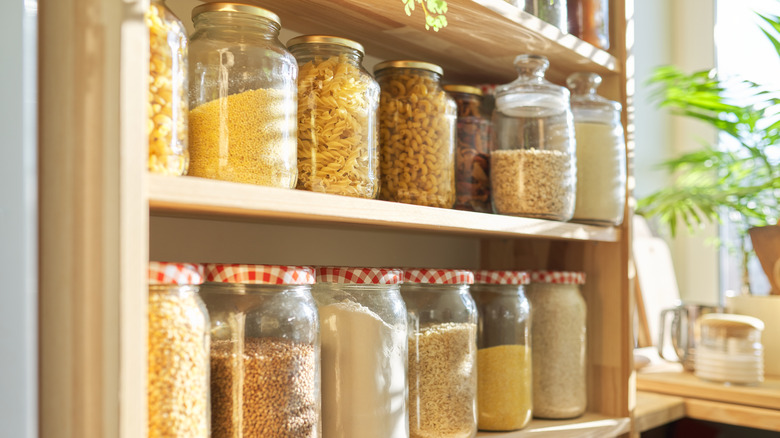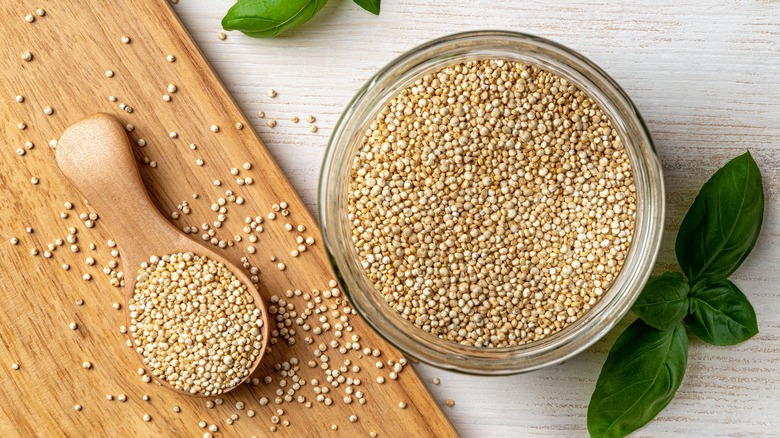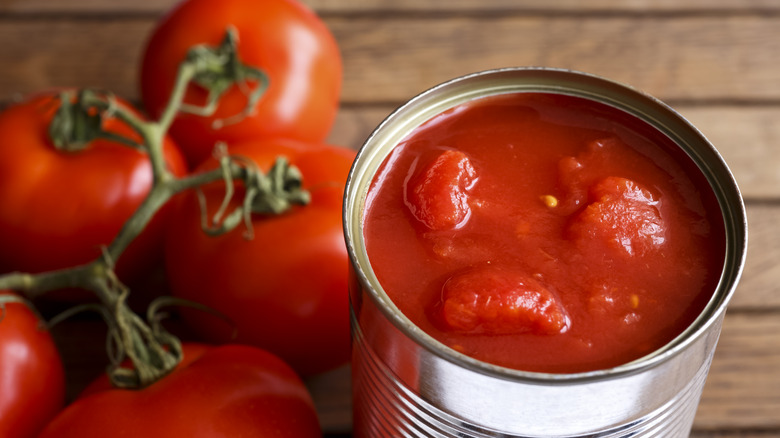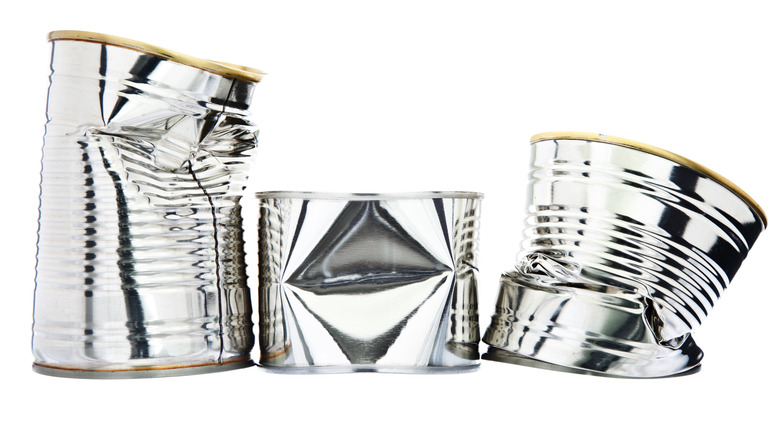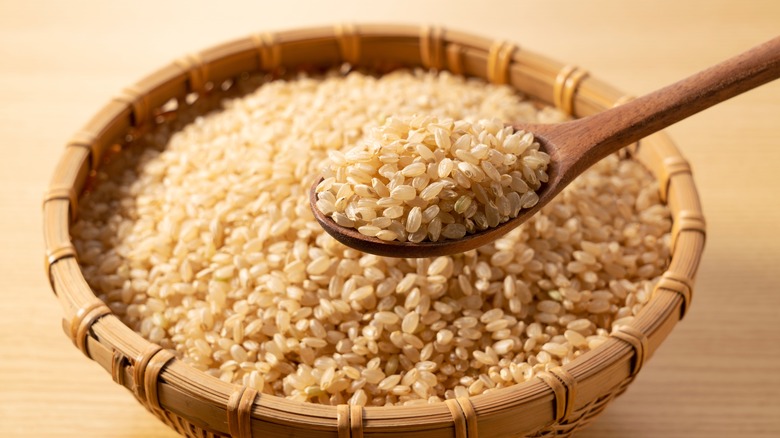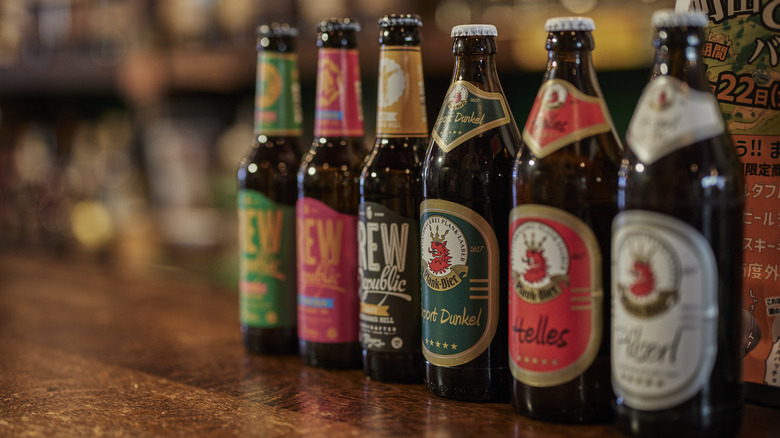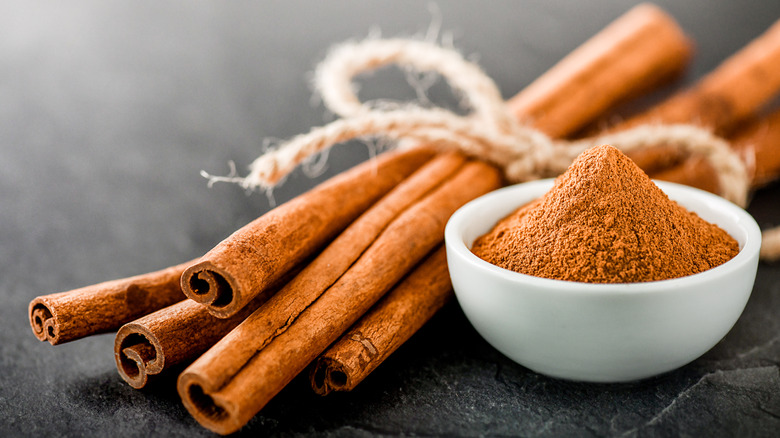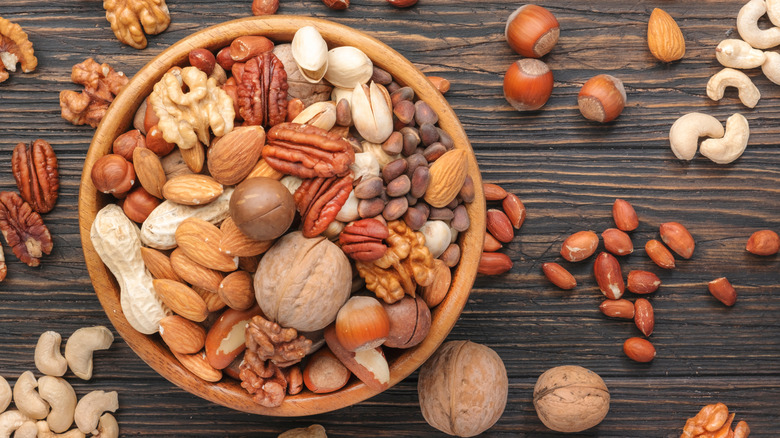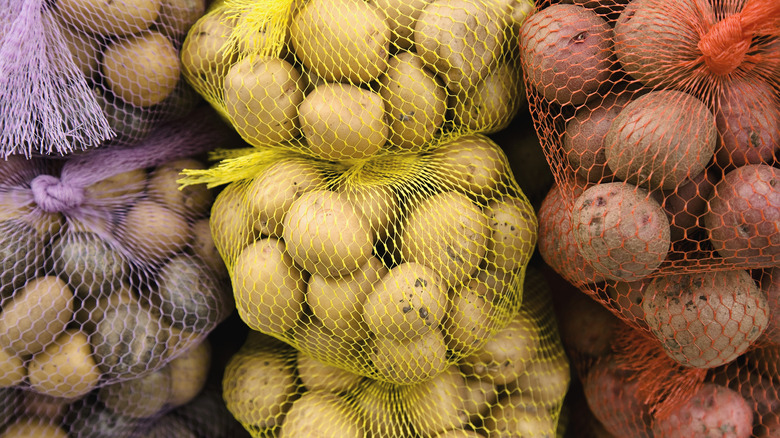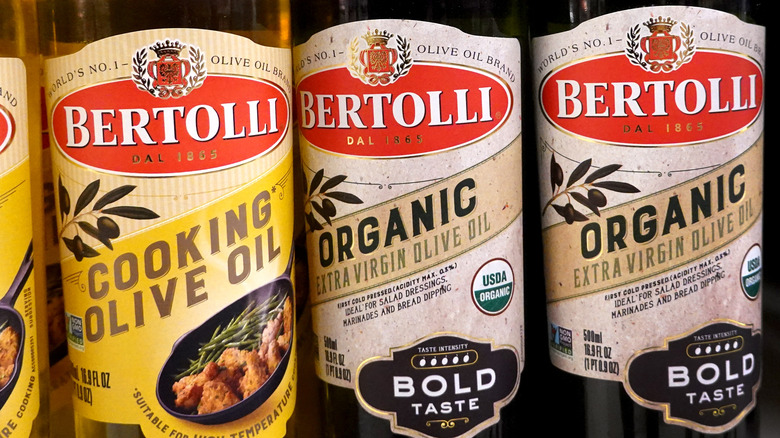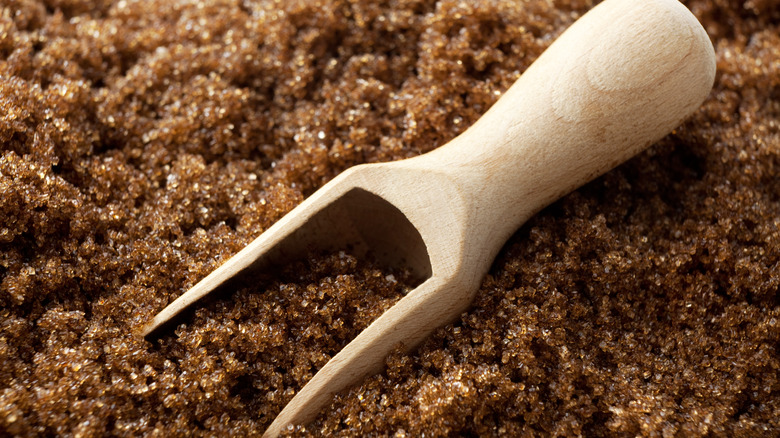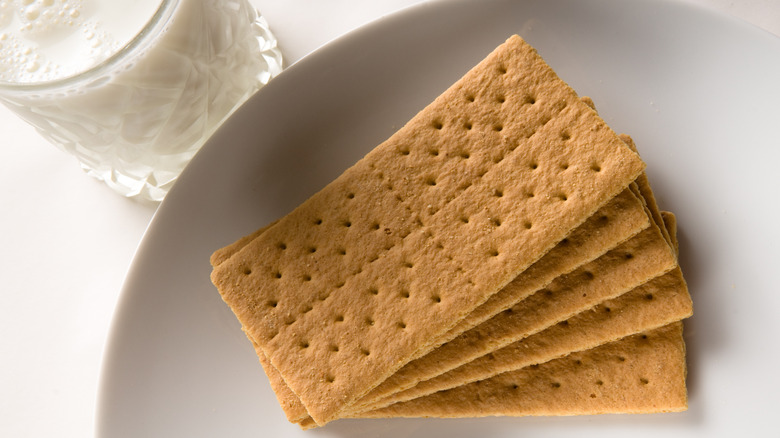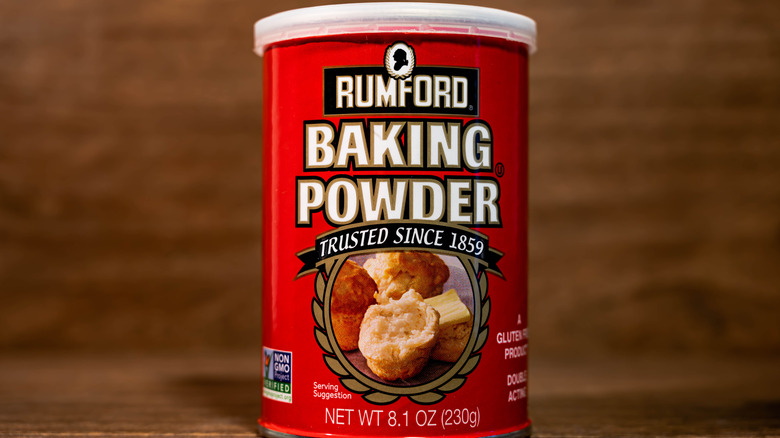14 Pantry Items That Expire Faster Than You Might Expect
Having a well-stocked pantry is the dream of any home chef. It means always having ingredients on hand with which to experiment or to throw together a last-minute meal that actually has some flavor. It means not having to stop at the store on your way home from work every day because you already have everything you need.
But there are dangers lurking in this kitchen utopia. Some pantry items might expire faster than you think, with some losing flavor and becoming useless, and others turning downright dangerous to your health. Some items might even expire sooner than what it says on the tin, depending on the environment they're in. In fact, as The New York Times reports, food expiration labels are largely voluntary and mostly guesswork. They represent a manufacturer's idea of when a particular food item may or may not be good to eat, which is a vague and subjective concept. What is far more helpful is to consider storage and packaging. If your pantry is a cool and dry place, you're off to a good start. If your packaging remains sealed and there are no dents in your cans, air and bacteria are unlikely to have gotten in and ruined your food. But let's take a look at which items might need more careful attention.
Quinoa
By the looks of it, quinoa is indestructible. It's just a dried grain sitting around, bothering no one. But according to the Whole Grain Society, a nonprofit consumer advocacy group, quinoa only lasts for up to four months in the pantry and eight months in the freezer. As a whole grain, it has more fat content than flour, which gives it a bit more of a buffer against spoilage, but at the same time, its lack of processing has kept intact its oils, which are vulnerable to temperature shifts. If you haven't been paying attention to the minor temperature ups and downs in your kitchen, just sniff your quinoa before using it. If you smell something — anything at all other than a faintly sweet fragrance — the grain is probably off.
But try not to mistake any unidentified whiffs for saponins. This substance is a defense mechanism that keeps animals from eating quinoa, and it can have a soapy, bitter taste. This is natural, not an indication of spoilage, and can be rinsed off with a bit of cold water.
Vitamins
Since vitamins are not required to include expiration labels, it may be hard to guess the moment they move past their prime. The good news is: If stored in a cool and dry place, vitamins are unlikely to develop mold. Healthline reports that to date, there have been no reported cases of people falling ill or dying as a result of ingesting expired vitamins. But capsules or pills do often lose their potency over time, which means you may not be getting the full benefits advertised on that bottle of large, chalky pills.
For example, if your label says one pill equals 100% RDA of Vitamin B12, that percentage could have dropped if you're taking the vitamin long after purchasing the bottle. In fact, while a sealed container of vitamins might look safe from the elements, it is not safe from time, and it is estimated that it will only last for two years in a pantry before it starts to lose its efficacy. This estimate should be revised downward when dealing with chewable vitamins, as gummies tend to let in more moisture, and therefore more potential for degradation.
Canned tomatoes
Most canned ingredients can last for years, even decades, but because of their high acid content, tomatoes are a different story. This corrodes cans more quickly, which affects the flavor of the contents while also giving rise to pathogens. This is why expiration estimates for canned tomatoes hover around the 12 to 18-month mark, while the contents remain safe to eat for up to a year after that. But safe to eat is not necessarily the same as good to eat, and you might end up having to use a product that doesn't taste, look, or feel like what you need for your recipe to succeed.
Fresh ingredients are always ideal, but if you have to use an old can of tomatoes or bust, it may not be the worst thing in the world. However, you might also want to consider how many contaminants you're willing to put into your body. While tomatoes are stored in steel cans that only experience small amounts of leaching of chrome and nickel, as reported by Scientific American, about 10% of food cans in the U.S. still contain Bisphenol A, or BPA. The FDA has deemed this substance safe in small amounts, but that's if you ignore reports of health problems linked to such small and safe amounts of BPA, which the National Toxicology Program has reported may cause disruption to brain development and the prostate gland, particularly in children.
Canned goods with dents, rust, or swelling
Any canned goods, whether they be tomatoes, beans, or whatever other post-apocalyptic food you might be storing in your underground bunker, are probably not safe to eat if the can comes rusted, swollen, or with major dents, especially those located in the seam of the can. These are indications that bacteria may have filtered in through a tiny, microscopic hole caused by the degradation of the can.
One such danger is the notorious clostridium botulinum, which the USDA says can lead to botulism and death, even if ingested in small amounts. This is no mere food poisoning: According to the CDC, this toxin can attack the body's nerves and present in the form of muscle weakness in the face, which can spread to weakness in the rest of the body, including the lungs. While botulism can be destroyed with heat — for example by cooking the contaminated product at 212 degrees Fahrenheit for 10 minutes — there is no 100% guarantee that the food will be made safe, and the risk of harm is just too great.
Brown rice
Brown rice may be the healthier choice, but it tends to last a lot shorter than its more highly processed cousin, white rice. That's because brown rice's higher oil content makes it more vulnerable to the elements, allowing moisture to degrade it more quickly. In fact, it is estimated that brown rice should grace your pantry shelf for no longer than six months. After that, the rice is liable to become rancid, which isn't fun for anybody.
Aside from potential gastrointestinal discomfort, you'll be consuming food that likely smells and tastes metallic, bitter, or soapy. This occurs because enzymes, oxygen, or heat start to break down the fat in the oil, causing oxidation to create fatty acids, which are responsible for rancidity. But the bad flavor is not the only peril. Mold can easily form in barely visible amounts, attracting small insects and other living beings you probably don't want to eat.
Beer
A flat and tasteless beer is probably one of the least satisfying sips anyone can experience. That is about as unpleasant as it gets when consuming expired beer, because as Brewer World reports, harmful bacteria already get destroyed during the brewing process, with the beer's alcohol content keeping most new threats at bay. But yucky beer is no one's idea of a good time, which is why you should pay close attention to the freshness of the beer you're currently storing in your pantry or garage.
As a general rule, canned or bottled beer can remain fresh on the shelf for up to eight months, a period that can be prolonged to 12 months through refrigeration. Beer kept in lighter-colored bottles can spoil more quickly, as ultraviolet light can seep in more easily, degrading isohumulone, a key compound generated by boiling hops during the brewing process. Meanwhile, beer with higher alcohol content is more likely to remain preserved for longer. Whatever type you choose, the best rule of thumb for storing beer is to buy it as fresh as possible in the first place. Look for bottling dates on the label; anything that has been produced in the last three months is unlikely to have suffered degradation yet.
Spices
On the one hand, spices can help flavor meat or other products that are past their prime, while also providing antioxidant anti-inflammatory properties to offset any potential health impacts from eating spoiled food, according to Healthline. But on the other hand, spices also have an expiration date of their own, especially if you've been storing them at a convenient arm's reach from your warm and toasty stovetop. This may come as a surprise: it's not uncommon for a person to keep ground turmeric or chili powder in their spice rack for years on end, even bringing them along during various moves. But such spices only have a shelf life of about two to three years when stored in a cool, dry place, though whole spices, such as whole peppercorns or fennel seeds, can last for up to four years.
Now, you might be wondering why you haven't gotten sick from adding that ground cumin to your steak last week. This is because expired spices don't actually harbor bacteria or pathogens. They simply lose their potency and flavor, suggesting that four-year-old cinnamon is tantamount to putting powdered air on your morning oatmeal.
Nuts
Oil is a substance that tends to attract rancidity, and nuts are chock full of oils, meaning the nuts in your pantry are only likely to last a handful of weeks. In fact, one could make the case that nuts shouldn't be left in the pantry at all. Keeping them in the fridge does nothing to harm their flavor or health benefits, and helps shelled nuts remain fresh for up to a year. In-shell nuts might even last double that.
To check whether nuts have gone rancid, aside from eating and choking on them, you can look out for a paint-like odor and dark, oily skin. Rancidity cannot be fixed or ignored, or you'll end up with a mouthful of sourness or bitterness. But if you find that your nuts are only slightly stale, you may be able to jump-start them a bit by roasting them in the oven.
Potatoes
Potatoes have been known to last for several months in cool, dark, and well-ventilated environments, making them an ideal pantry item. However, if these conditions are not met, things start to deteriorate quickly. A number of things can happen at this point: The potatoes may start to green, which occurs when chlorophyll builds up inside the potato, causing the tuber to develop a toxic alkaloid that can give you food poisoning in large doses; the potatoes might start to lose their moisture and shrivel up; and spuds might appear. In all of these scenarios, the potatoes are still safe to eat, with a few modifications, like cutting off the degraded parts. But be aware that they are symptoms of impending spoilage — the potatoes need to be eaten now or get thrown away.
Storing potatoes in the fridge can be an option if you want to keep them fresh for longer, but the cold will interact with the starch in such a way that when you cook the potatoes, they may yield a sweeter, darker result.
Olive Oil
This product is nearly indestructible if stored in an unopened can, but once it's open, the flavor could turn rancid in just a few months, especially if you keep it right by the stove, which is often the warmest part of the kitchen. In fact, there's nothing wrong with keeping your olive oil in the fridge if it's not something you use on a daily basis. It'll congeal and turn opaque, but you'll be able to use it just fine if you take it out about an hour before cooking time.
The color of the bottle it comes in also matters, as darker glass will keep out light and its oxidation effects. And make sure you're also aware of the level of processing of your olive oil: the minimally processed, extra-virgil olive oil may taste better and be better for you, but it tends to go off sooner than its more processed counterparts.
Brown sugar
The problem with brown sugar is not so much that it'll go bad, but that it will become hard as a rock and virtually unusable in just under four months. It remains safe to eat if you can manage to break it up into something useful, which is possible, but that's hard work.
One such method is to place an apple slice in your bag of brown sugar and leave it there overnight. The apple will transfer just enough moisture to the sugar to revive it and loosen it. If you're pressed for time, try the microwave method, where you place the sugar in a bowl covered with a damp paper towel and zap it for 20 seconds at a time until it crumbles apart, but before it turns into a giant blob of caramel. However, you can prevent a repeat incident just by taking the sugar out of its original packaging and storing it in a sealed bag. This will keep the air out and avoid the resulting hardening.
Green tea
One might think that all tea is created equal, and in part, one would be right. In fact, black, green, and white tea leaves all come from the same plant, but get turned into one or the other through an oxidation process. The darker teas last the longest because they've gone through the longest oxidation process. Black tea, for example, can last for up to three years in the pantry, while green tea, one of the least oxidized products, might only last for six months if you're lucky. Your green tea is even more likely to expire fast if it comes in tea bags, which tend to use minuscule tea leaf shavings that are much smaller than the loose leaf variety.
Since exposure to air is the main culprit here, the smaller the leaf, the faster it will expire. And just as with spices, while tea itself might not go bad per se, it will lose its flavor, turning a nice cup of tea into a simple cup of hot water with a funky color.
Graham crackers
Make sure you eat as many s'mores as possible this summer because those leftover graham crackers are not going to last until next year. Even when unopened and left untouched in their original packaging, they can go stale in less than nine months. You may still safely eat expired graham crackers, in the form of soft and floppy morsels, but they certainly won't give you the crunch you need for a proper s'more. In fact, expired graham crackers may slightly shift in color and taste, but the biggest clue of their demise will be the texture. In particular look out for a cracker that is too stiff, too crumbly, or too sticky.
The best thing to do to preserve them is to stick them in a sealed bag or container. But whatever you do, don't refrigerate or freeze them. Crystals may start to form on the crackers in cold environments, melting into water once you return them to room temperature and thereby turning these crispy wonders into sad, soggy pieces of mush.
Baking powder
Unless you bake a lot, that shiny red tin of Rumford baking powder that has been sitting in your cupboard has probably already expired. In fact, the shelf life of baking powder — not to be confused with baking soda, which is a component of baking powder — is widely estimated to be not much more than six months. To find out whether your baking powder really has expired, you can test it by pouring a small amount into a bowl and adding some boiling water. If your mixture bubbles up, the baking powder is still active. If not, it's time to toss it.
According to Livestrong, the risk of using expired baking powder is not so much to your health, but to your carefully crafted sheet cake, which might not rise in the least, leaving you with a flat, dense brick to somehow dispose of. Sure, you'll probably eat it all anyway, but you're not going to be happy about it.
